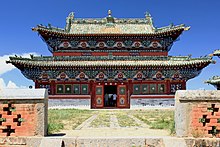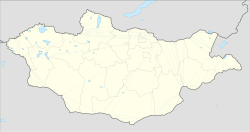Erdene Zuu Monastery
| Erdene Zuu Monastery Эрдэнэ Зуу хийд ལྷུན་གྲུབ་བདེ་ཆེན་གླིང་ | |
|---|---|
 Erdene Zuu Monastery | |
| Religion | |
| Affiliation | Tibetan Buddhism |
| Sect | Gelug |
| Location | |
| Location | Near Kharkhorin, Övörkhangai Province, Mongolia |
| Country | Mongolia |
| Geographic coordinates | 47°12′06″N 102°50′36″E / 47.20167°N 102.84333°E |
| Architecture | |
| Founder | Abtai Sain Khan |
| Date established | 1585 |
The Erdene Zuu Monastery (
Orkhon Valley Cultural Landscape World Heritage Site.[1] The monastery is affiliated with the Gelug sect of Tibetan Buddhism.[2]
History
Tibetan Buddhist rosary featuring 108 stupas (108 being a sacred number in Buddhism),[5] but this objective was probably never achieved.[6]
The monastery's temple walls were painted, and the Chinese-style roof covered with green tiles.
The monastery was damaged in 1688 during one of the many wars between
Dzungars and Khalkha Mongols. Locals dismantled the wooden fortifications of the abandoned monastery.[7]
It w
According to tradition, in 1745, a local Buddhist disciple named Bunia made several unsuccessful attempts to fly with a device he invented which was similar to a parachute.[7]

In 1939, the communist leader
Gandantegchinlen Khiid Monastery
became Mongolia's only functioning monastery.
After the fall of communism in Mongolia in 1990, the monastery was turned over to the lamas and Erdene Zuu again became a place of worship. Today, Erdene Zuu remains an active Buddhist monastery as well as a museum that is open to tourists.
On a hill outside the monastery sits a stone phallus called Kharkhorin Rock. The phallus is said to restrain the sexual impulses of the monks and ensure their good behavior.[12]
Gallery
-
Main gate
-
Lavrin Temple
-
The "Golden Stupa" at Erdene Zuu
-
The Temple of Dalai Lama
-
Gol Zuu Temple
-
Eastern Zuu Temple
-
Stupas
-
Sanjaa (Buddha Dīpankara) inside Western Temple
-
Buddha Sakyamuni inside Western Temple
-
Sita Mahakala (Gonggor) inside Main Temple
-
Buddha Amitābha (The Buddha of Immeasurable Life and Light) inside Main Temple
-
Buddha in his teenage years inside Eastern Temple
-
Stone Turtle near to the Monastery Erdene Zuu
-
Phallic Rock
-
Gift shop and museum
Notes
References
- ^ "Orkhon Valley Cultural Landscape". Retrieved 12 March 2013.
- ]
- ^ "Erdene Zuu Monastery". Culture Mongolia. Archived from the original on 2007-04-06. Retrieved 2007-03-12.
- ^ "Karakorum". Culture Mongolia. Archived from the original on 2007-04-06. Retrieved 2007-03-12.
- ^ Snipe, Lynn "Jnana". "Buddhism in the Numbers". Urban Dharma. Retrieved 2007-03-12.
- ^ Niels Gutschow, Andreas Brandt, Die Baugeschichte der Klosteranlage von Erdeni Joo (Erdenezuu), in Claudius Müller (ed.), Dschingis Khan und seine Erben, Bonn 2005, p.353
- ^ a b "Erdene Zuu monastery". Wondermondo.
- ^ http://www.ciaonet.org/atlas/countries/mn_data_loc.html#a6
- ^ "Dalai Lama's visit shines spotlight on Mongolia's explosion of faiths". USA Todays.com. 2006-08-24. Archived from the original on 2007-09-27. Retrieved 2007-03-12.
- ^ "Terror Years". Issue 6. Mongolia Today. Archived from the original on 2007-06-07. Retrieved 2007-03-12.
- ISSN 1527-6457. Archived from the originalon 2007-05-31. Retrieved 2007-03-12.
- ^ "Kharakhorum (Karakorum)". Sights of Interest in Mongolia. Legend Tour. Archived from the original on June 4, 2008. Retrieved 2007-03-12.
External links
Wikimedia Commons has media related to Erdene Zuu Monastery.
- Official website
- Article Archived 2010-07-26 at the Wayback Machine with pictures
- Encyclopædia Britannica article on Karakorum and Erdene Zuu.
- Photo collection at Culture Mongolia
- A few pictures
- Excerpt from article "The Life of Zanabazar"; discusses the construction of Erdene Zuu
















